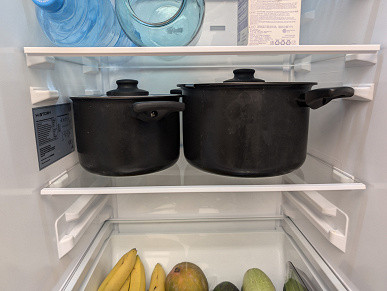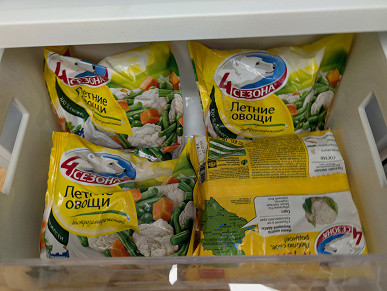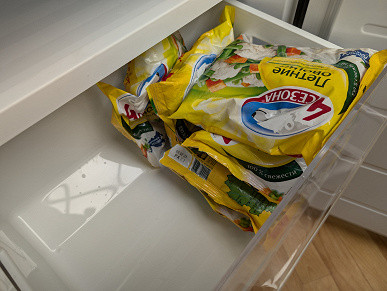The ideal refrigerator for us is easy to use, spacious and quiet. If it does not require manual defrosting, that's great. And the presence of various modes and settings makes it even more attractive.
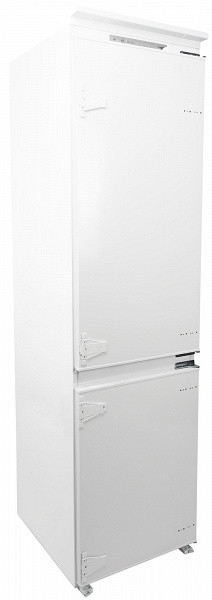
Does the built-in HiStory BRB 1940MI meet these criteria? Let's take a closer look at it during testing.
Characteristics
| Manufacturer | History |
|---|---|
| Model | BRB 1940MI |
| Type | built-in two-chamber refrigerator |
| Country of origin | China |
| Guarantee | 2 years |
| Service life * | 10 years |
| Embedding | fully built-in |
| Defrosting | Total No Frost |
| Energy efficiency class | A++ |
| Power | 276 W |
| Control | electronic |
| Number of cameras | 2 |
| Reversible doors | There is |
| Total volume | 326 l |
| Useful volume | 300 l |
| Volume of the refrigeration chamber | total — 222 l useful — 213 l |
| Freezer capacity | total — 104 l useful — 87 l |
| Facade material | PCM steel |
| Shelf material | glass |
| Number of shelves in the refrigerator compartment | 4 |
| Shelves on the door | 4 |
| Number of drawers in the freezer compartment | 2 |
| Number of shelves in the freezer compartment | 1 |
| Compressor | inverter (GMCC-Toshiba) |
| Freezing power | 6 kg/day |
| Climate class | SN/N/ST/T |
| Super freeze function | There is |
| Supercooling function | There is |
| Vacation mode | There is |
| Coolant | R600A, 30 g |
| Autonomous cold storage | 9 hours |
| Maximum noise level | 35 dB |
| Weight | 70 kg |
| Dimensions (W×H×D) | 540×1977×550 mm |
| Length of network cable | 1.5 m |
* Contrary to popular belief, this is not a period after which the device will necessarily break down. However, after this period, the manufacturer ceases to bear any responsibility for its functionality and has the right to refuse to repair it, even for a fee.
Equipment
The HiStory BRB 1940MI refrigerator arrived for testing in a brown cardboard package, secured with nylon straps to a foam base. The box contains minimal information: the manufacturer's logo, model index, and shipping instructions.

Inside the box we found the refrigerator itself, a user manual, installation instructions, a sticker with information on energy efficiency, and a set of hardware for re-hanging the doors.
There are no additional accessories, such as an ice tray or an egg cup. However, this is not a serious problem: often standard accessories are inexpensive and require replacement as they are used.
At first glance
Like other built-in kitchen appliances, the BRB 1940MI refrigerator has no external decorations: its body will be hidden in a niche of the kitchen unit, and the doors will be closed with front panels.
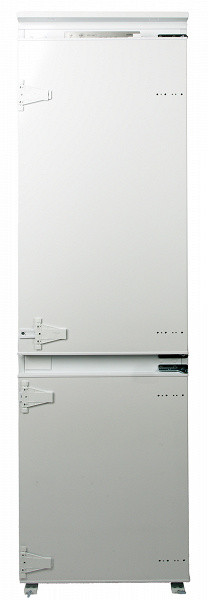
The refrigerator has a classic two-chamber layout: the upper part is occupied by the refrigerator chamber, and the freezer is at the bottom.
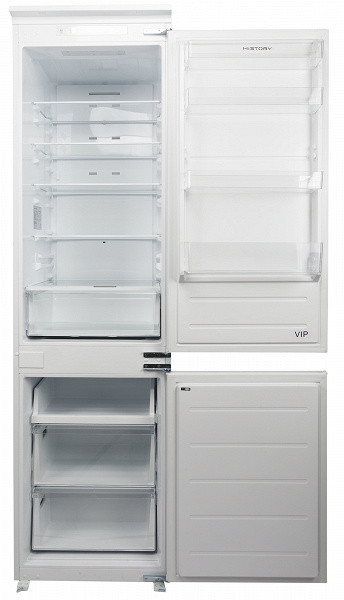
The refrigerator compartment is equipped with four tempered glass shelves, which, according to the manufacturer, can withstand up to 15 kg and are framed with plastic sides. The shelves can be placed in two height options thanks to adjustable walls.

The fifth shelf, which also functions as a lid for the freshness zone, naturally does not allow for any variations.

The rear wall of the refrigerator compartment features ventilation holes. The Dual Fresh Cooling System maintains stable temperature and humidity separately in the refrigerator and freezer compartments.
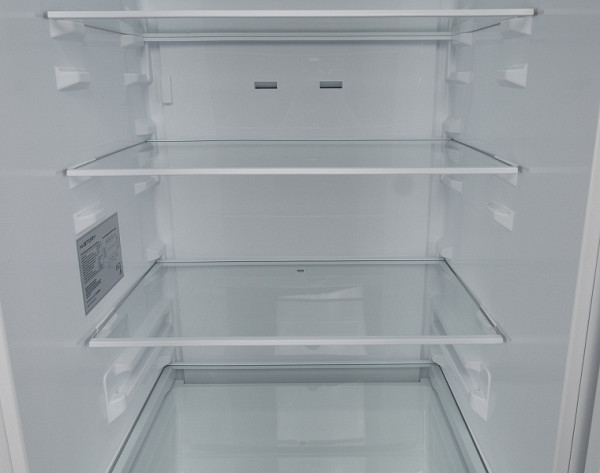
The cold air flows are evenly distributed throughout the entire volume, which, according to the manufacturer, ensures stable cooling to the set temperatures in each chamber without significant temperature gradients. This statement will be verified during laboratory tests.
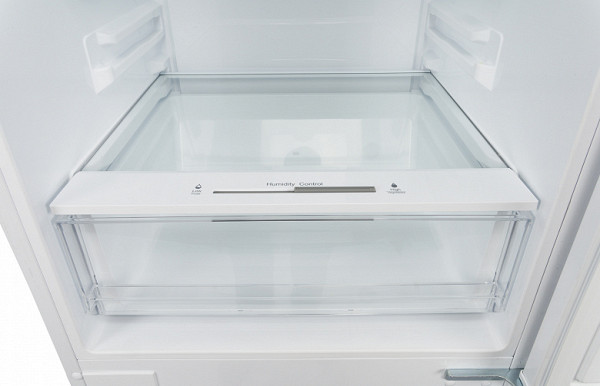
The freshness zone is a pull-out plastic drawer with a tempered glass lid, the same as the shelves.
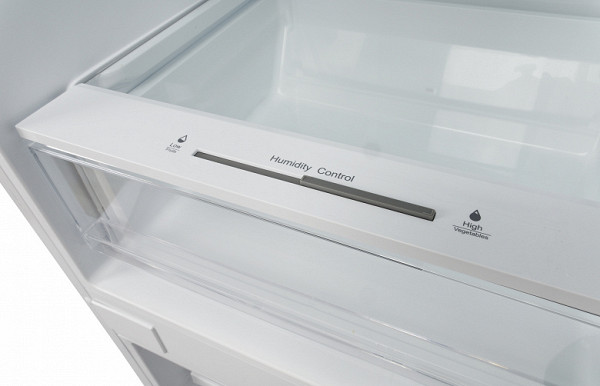
The lid of this compartment is equipped with a humidity regulator in the form of a sliding slider. The fully closed position maintains increased humidity, ideal for storing fresh vegetables, while the fully open position is intended for fruits, which prefer a drier climate. The freshness zone has no partitions, providing a common volume for all products placed in this compartment.
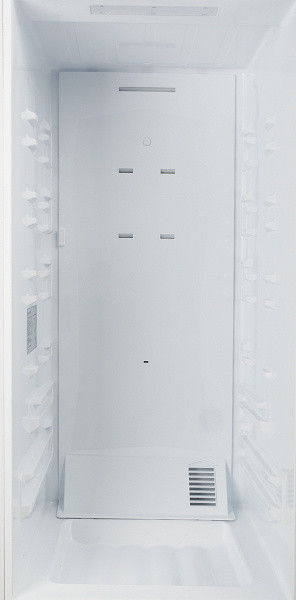
At the bottom of the refrigeration compartment you can see a large ventilation grille: this is where cooled air enters the chamber.
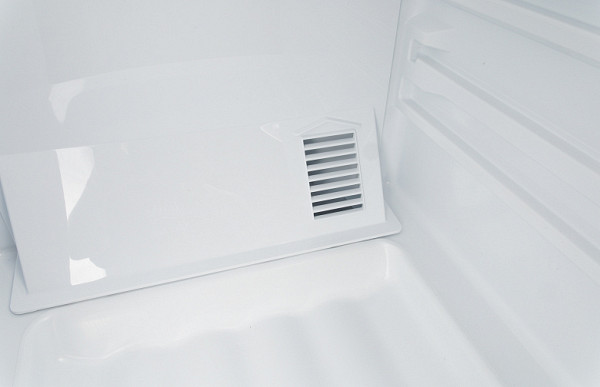
The plastic grille cover protrudes from the back wall, leaving narrow free spaces on the sides. To maintain the device, the user will need brushes or sponges of the appropriate size to easily clean these areas.

There are four plastic shelves on the refrigerator compartment door. Three of them have a fixed position, and the fourth (third from the top) allows installation in two options: slightly higher or slightly lower.

The freezer compartment has two drawers with transparent front walls and one shelf above them. The drawers are the same height but have different depths: under the lower drawer there is a niche for the refrigeration unit.
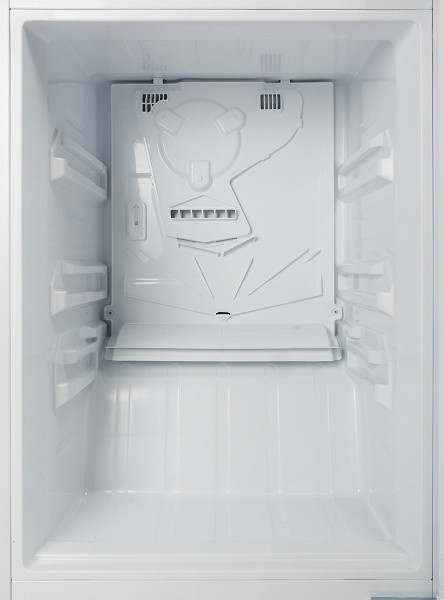
The freezer compartment is powered by a second cooling circuit. The flow of cold air is distributed by a complex-shaped ventilation panel on the rear wall of the chamber.

The metal side walls without protruding elements are painted with white enamel paint: let us remember that we have a fully built-in device in front of us.

The lower part of the unpainted aluminum rear panel contains a niche for the refrigeration unit. This model is equipped with a GMCC-Toshiba inverter compressor, which provides stable temperature, low noise level (35 dB) and high energy efficiency (class A++).

Next to the niche is an evaporator with a plastic tray for condensate. Heating and evaporation of the resulting liquid is provided by a heat exchanger tube immersed in the container.
Instructions
The user manual is a 20-page A5 brochure.

The manual briefly explains how to prepare the device for operation, set it up and use it. It includes many diagrams and drawings that illustrate the design and operation of the refrigerator, and also serves as a service book.
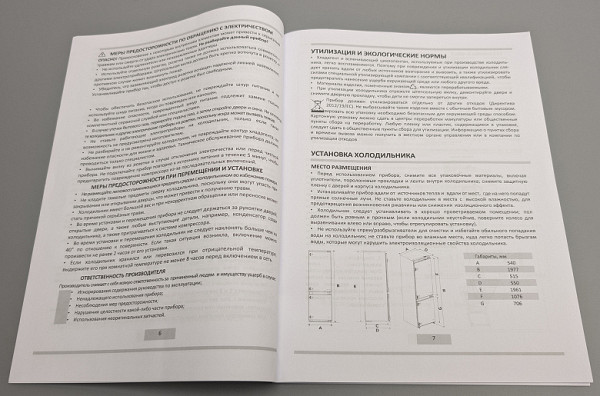
The set of documents also includes a sticker with information about its energy efficiency.
Control
On the silver panel located above the refrigerator door there are two touch buttons, to the right of which are white LED indicators.

All the inscriptions on the panel are in English. The temperature in the refrigerator compartment is controlled by the «Fridge» button, and in the freezer compartment by the «Freezer» button.
Each compartment has four operating modes. Successive pressing of the corresponding sensor allows you to select minimum, medium or maximum cooling and freezing. The indicators on the panel («Cold», «Colder», «Coldest») display the selected mode.
This model does not allow you to accurately set the temperature in the refrigerator or freezer compartments.

The last press activates the Super Cool mode for the refrigerator compartment and the Super Freezer mode for the freezer compartment. These modes are designed for quick cooling or freezing of large quantities of food.
In the Super Cool mode, the refrigerator operates at maximum power for 6 hours, then returns to the previous settings. In the Super Freezer mode, the device operates at full power for 40 hours. If you plan to load a large quantity of food into the freezer, it is recommended to turn on the function in advance — 12 hours before.
The Super Cool and Super Freezer functions can be stopped earlier by pressing the Fridge and Freezer sensors, respectively.
To save energy during a long absence, you can activate the Vacation mode. In this mode, the cooling of the refrigerator compartment is turned off, and the freezer goes into the medium operating mode («Colder»). To turn this function on or off, hold the Freezer button for 10 seconds, the Light on/Vacation indicator will turn on or off.
To put the unit into standby mode, hold the Fridge button for 10 seconds.
Operation
When choosing a location for the refrigerator, it is important to avoid heat sources and direct sunlight, and not to install it in places with high humidity.
It is recommended to place the refrigerator in a well-ventilated room on a flat and solid surface. After installation (details of the procedure are given in the attached instructions), it should be leveled by adjusting the front legs to avoid unnecessary noise and ensure optimal operation of the device.
If necessary, the refrigerator doors can be re-hung to the left side. The design allows this, and detailed instructions for re-hanging are provided in the user manual.
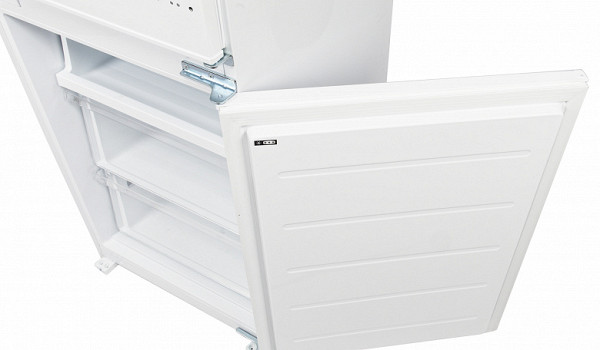
After transportation, the refrigerator should be left alone for 2 hours before being plugged in to allow the oil in the compressor to settle. Then, before filling it with food, it is recommended to let the device run idle for 2-4 hours, depending on the room temperature.
This model is equipped with a refrigerator compartment door open alarm. If the door remains open for more than one minute, a long beep sounds, which stops only after the door is closed. The freezer does not have such an alarm.

Rear/left and front/right walls of the refrigerator in the infrared range
The refrigerator's heat exchanger is located on the rear wall in the unit's niche, which is a good solution for built-in appliances. Infrared photos show that the side surfaces of the unit remain cool.
IR images also show that the door seals of the refrigerator and freezer compartments are heated. This design helps dry condensation and prevents ice from forming.
In addition to traditional capacity measurements using a ruler and tape measure, we will show the capabilities of the refrigerator using more visual examples.

Four glass shelves provide flexible organization of space in the refrigerator compartment: each of them can be installed in two versions.
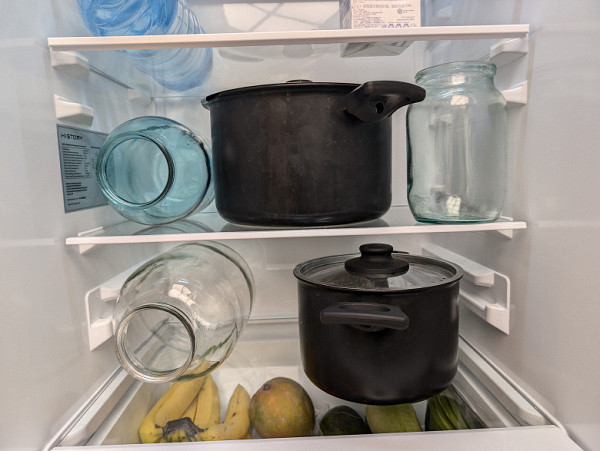
The two lower shelves are perfect for pots up to three or even five liters. Classic Ikea containers can be placed here without removing the lid. However, to store two- or three-liter glass jars, you will need to remove one of the shelves.
The width of the chamber allows you to place both pans side by side.
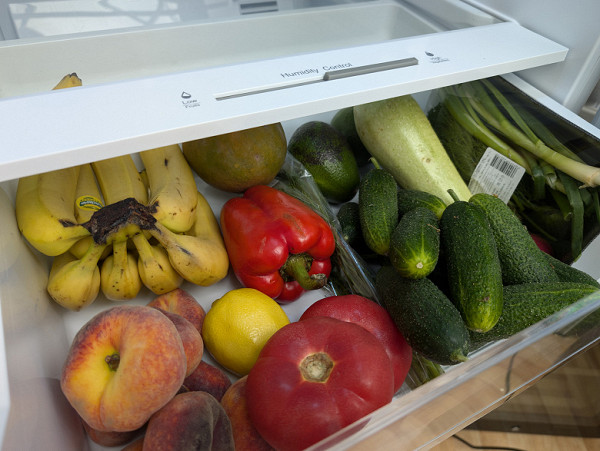
The capacity of the freshness zone is large enough to store a large volume of fresh vegetables and fruits. The slider for adjusting humidity allows you to create an optimal microclimate inside the box. However, it does not have dividers and partitions, so the user will have to independently adjust the flap for all the contents of the box.
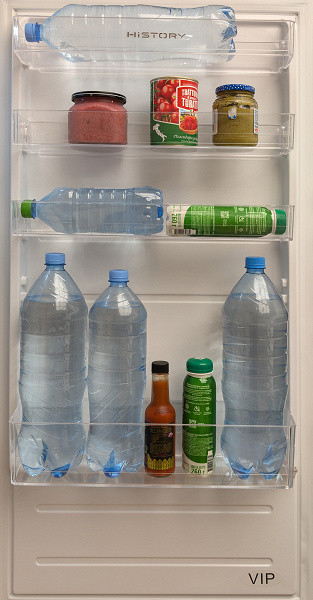
Of the four shelves on the door, only the third from the top can be adjusted, and it can be set in two positions. In the upper position, the lower shelf can hold up to four two-liter bottles.
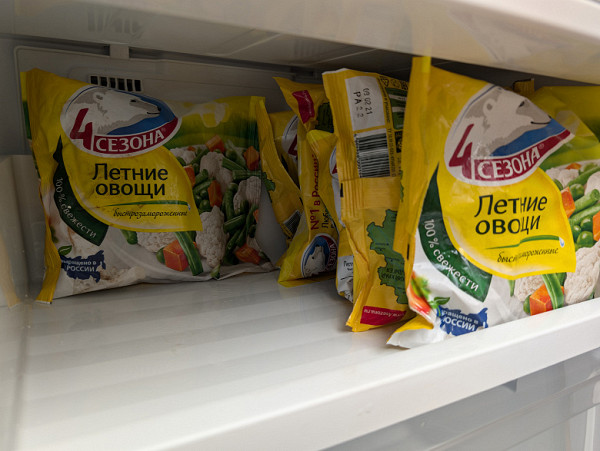
We measure the volume of the freezer compartment with standard 400-gram packages of frozen vegetables. The top shelf can accommodate ten packages, five in each row.
The useful volume of the middle drawer is noticeably larger: we easily placed twelve packages here — two stacks of four horizontally and two packages vertically.
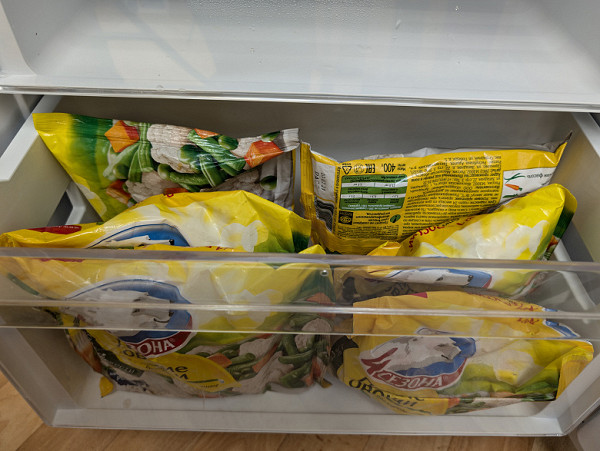
The depth of the lower drawer is noticeably smaller due to the niche of the refrigeration unit. It only holds six bags of vegetables.
Care
The refrigerator and freezer compartments do not require manual defrosting thanks to the Total NoFrost system.
To prevent unpleasant odors, it is recommended to periodically clean the interior surfaces with a weak soda solution (two tablespoons per liter of warm water). After that, the solution should be washed off with warm clean water using a soft sponge or cloth and the surfaces should be wiped dry.
Do not use hard or abrasive objects, organic solvents, hot water, acids or alkalis for cleaning.
The sealing rubber should be regularly wiped with a damp sponge.
Our measurements
The useful volume of the refrigerator is defined as the total volume of all drawers and shelves, measured inside each element. This figure differs from the value specified by the manufacturer, since manufacturers indicate the full volume of the compartments, and we measure the useful volume.
The measured volume of the freezer compartment drawers is (39×17×27) + (40×27×18) + (40×18×18) = 17901 + 19440 + 12960 = 50301 cm³. Thus, the total volume of the freezer drawers is 50.3 liters.
The useful volume of the refrigerator compartment shelves, according to our measurements, is 30×47×85 = 119850 cm³, or 119.9 liters. The volume of the freshness zone drawer is 36×43×16 = 24768 cm³. Adding the volume of the door shelves (41×11×75 = 33825 cm³ = 34 liters), the total useful volume of the refrigeration compartment is 178443 cm³, or 178 liters.
We measured the energy consumption of the device in maximum power mode for 3 days, during which time the refrigerator consumed 1.714 kW h. Accordingly, the maximum daily energy consumption is 0.571 kW h.
The noise of the compressor does not exceed 35 dB (A).
| Useful capacity of the freezer compartment | 50.3 l |
|---|---|
| Useful capacity of the refrigerator compartment | 178 l |
| Maximum recorded power consumption | 186.7 W |
| Daily energy consumption in maximum mode | 0.571 kWh |
| Noise level when the compressor is running | 35 dB(A) |
To measure the performance of refrigerators and freezers, as well as to evaluate their thermal insulation, our laboratory has developed a hardware and software system based on the Arduino mini-computer and DS18B20 digital sensors. These sensors operate in the temperature range from -55 to +125 °C and provide an accuracy of ±0.5 °C in the range from -10 to +85 °C.
To eliminate the influence of the processor's heat generation on the microclimate inside the chamber and the measurement results, the device is placed outside the refrigerator. The sensors are connected to the mini-computer using three wires with a cross-section of 0.3 mm², which are hermetically passed under the door seal.
Freezer Dimensions
Two hermetically sealed temperature sensors were placed in four-liter plastic containers filled with water. We installed one container on the top shelf of the refrigerator, and the second in the middle drawer of the freezer (since the volume of the bottom drawer was insufficient to accommodate both containers). The sensor capsules were placed as close to the center of the containers as possible.
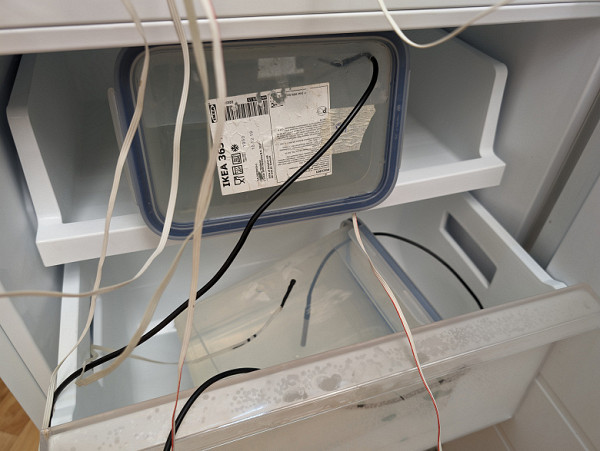
In addition to water temperature sensors, we also used air temperature sensors. These sensors were located near the containers, but the sensors did not directly contact the elements of the freezer body.
The total volume of frozen ballast was 8 liters.
Refrigerator chamber measurements
To simulate the operation of a full refrigerator, we used water ballast in the same 4-liter containers used for the freezer during the refrigerator compartment testing. In addition, several plastic bottles of water were placed on the shelves and door of the refrigerator.
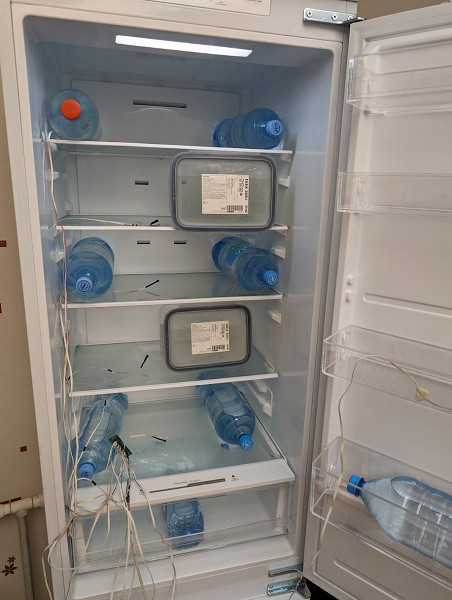
The air temperature in the refrigeration chamber was measured using seven sensors: five were placed on the shelves as close to their center as possible, the sixth was lowered into the freshness zone drawer, and the seventh was attached to the middle shelf on the refrigerator door. The total volume of cooled ballast was 23 liters.
Operation of the refrigeration chamber
The temperature in the refrigerator chamber depends not only on the set mode, but also on the location of the products. We turned on the refrigerator with ballast in the supercooling mode and monitored the temperature change in the chamber until stable thermometer readings were achieved (shelf numbers are indicated from top to bottom). The measurement results are presented in the graph.
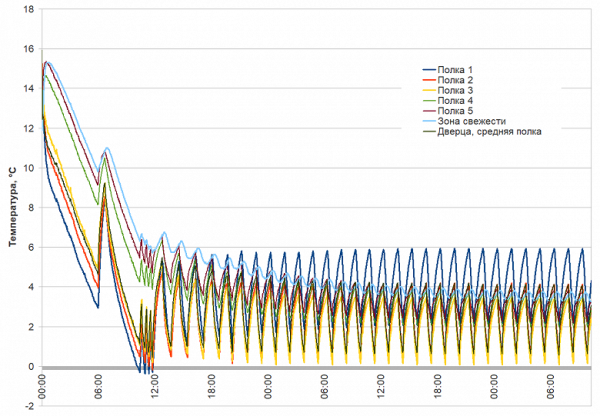
As stated in the instructions, in the super freeze mode, the device operated at maximum power for six hours, then the compressor paused for two hours, worked continuously for three hours again and switched to pulse mode.
Power is adjusted by turning the engine on and off. Details of the device's operation can be seen in the enlarged graph.
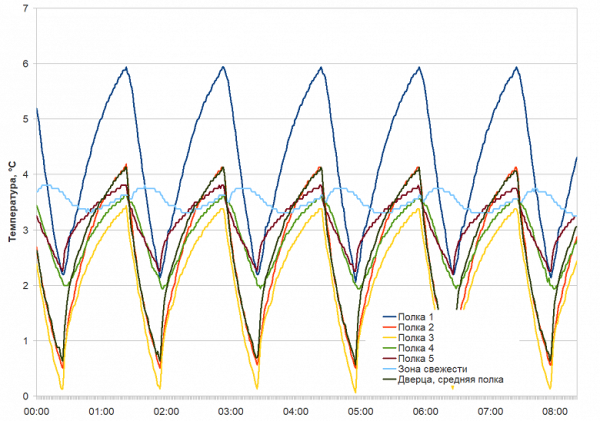
The graph shows that the temperature at each measurement point fluctuates with a period of about an hour and a half: it decreases when the compressor is turned on and gradually increases after it is turned off. The microclimate of the freshness zone is more stable. In the refrigeration compartment drawer, there are smaller temperature and humidity fluctuations, which helps maintain the freshness of meat, greens and fruits.
It should be noted that the graphs reflect the operating features of the refrigeration unit and the circulation of cold air, and not the consumer qualities of the refrigerator. Significant temperature fluctuations are explained by the fact that chilled products have greater thermal inertia compared to the air in the chamber and normally tolerate cyclic temperature changes.
For consumers, the average temperature in different zones of the refrigerator is more important. We measured this temperature during the day on each shelf of the refrigeration compartment in the maximum cooling mode and summarized the results in a table.
| Temperature | maximum | minimal | average |
|---|---|---|---|
| Shelf 1 | 5.9 | 2.1 | 4.3 |
| Shelf 2 | 4.2 | 0.5 | 2.6 |
| Shelf 3 | 3.4 | 0,1 | 2.1 |
| Shelf 4 | 3.6 | 1.9 | 2.8 |
| Shelf 5 | 3.8 | 2,2 | 3.1 |
| Freshness zone | 3.8 | 3.2 | 3.5 |
| Door, middle shelf | 4.1 | 0.6 | 2.7 |
Thanks to the ventilation system, the temperature in all areas of the refrigeration compartment does not vary too much. We observe the smallest spread in the freshness zone and on the two lower shelves, and the greatest temperature fluctuations are on the three upper shelves.
Freezer operation
To evaluate the freezing capacity of the refrigerator, we placed containers of room temperature water on the top shelf and in the middle drawer of the freezer, and then activated the super freeze mode. The results of the water and air temperature measurements are presented in the graph below.
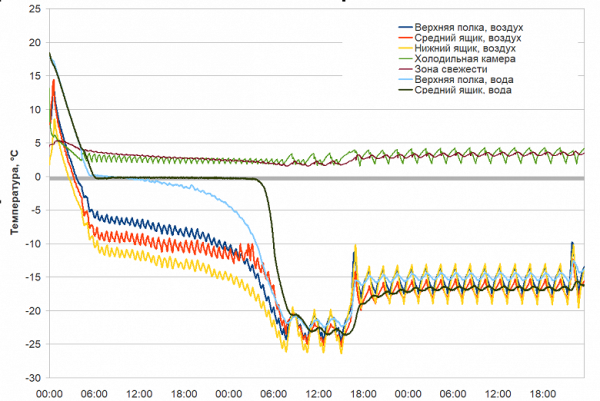
The water in the four-liter container on the top shelf froze after about 12 hours, and in the same container placed in the middle drawer of the freezer, it froze after 36 hours. After the specified time of operation in the super freeze mode, i.e. after 40 hours, the refrigerator returned to normal mode.
Defrosting the refrigerator
To evaluate the thermal insulation of the case and determine how long the unit retains cold after being disconnected from the mains, we turned off a pre-cooled refrigerator with ballast and monitored the temperature change.
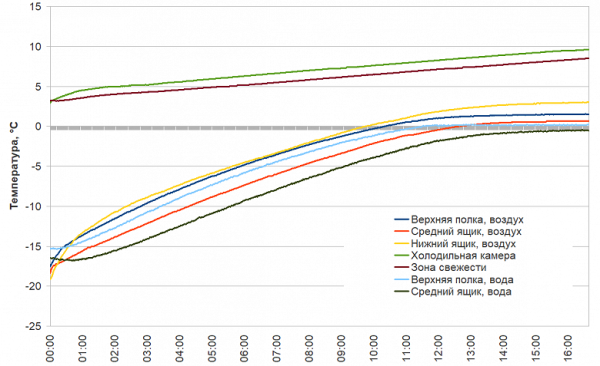
The graph shows that the temperature in the top-shelf bin reached freezing approximately 11 hours after the test began. The ice in the middle bin began to melt much later, approximately 39 hours after the power was turned off.
Power consumption measurements
In normal operation, the temperature in HiStory BRB 1940MI is regulated by turning the compressor on and off with a period of about an hour and a half. In this case, the device consumes about 37-39 W.

When switching cooling modes (for example, from “Cold” to “Colder” or “Coldest”), power consumption can reach peak values of up to 178 W and then gradually decrease to 80-90 W until the temperature inside the chamber reaches the desired level.
Conclusions
The built-in two-chamber refrigerator HiStory BRB 1940MI impresses with its ease of operation and functional organization of the space inside. The flexible configuration of the shelves allows you to conveniently place containers of any size.
An effective ventilation system ensures rapid temperature recovery after closing the doors of the refrigerator and freezer chambers. Supercooling and superfreezing modes ensure prompt cooling or freezing of large volumes of products, preserving their appearance and nutritional properties.
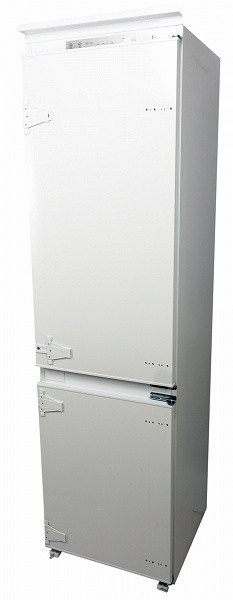
The vacation mode helps save energy and maintain the safety of food in the freezer when the owner leaves the house for a long time.
This model does not have the ability to accurately set the temperature in both chambers: only relative cooling intensity settings are available. Although this may take some time to get used to, we do not consider this a significant drawback.
Adjusting the microclimate in the fresh zone allows you to set the optimal humidity for storing vegetables or fruits. If you plan to store both, the user will have to find a compromise with a single slider, since there are no dividers or partitions in the fresh zone.
Pros:
- easy control
- separate ventilation system for the refrigeration and freezer chambers
- fresh zone with controlled microclimate
- Total NoFrost
- low noise level
Cons:
- no way to accurately set the temperature in the refrigeration and freezer chambers
- microclimate control of the fresh zone controls humidity throughout the volume

